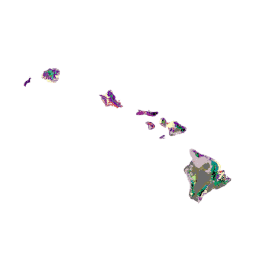
- זמינות מערך הנתונים
- 2001-01-01T00:00:00Z–2002-01-01T00:00:00Z
- ספק מערך נתונים
- USGS
- תגים
תיאור
הנתונים של GAP/LANDFIRE National Terrestrial Ecosystems מייצגים סיווג מפורט של צמחייה וכיסוי קרקע בארה"ב הרציפה, אלסקה, הוואי ופוארטו ריקו. מערכות אקולוגיות של GAP/LF 2011 עבור ארה"ב הגובלת היא עדכון של נתוני כיסוי הקרקע של התוכנית הלאומית לניתוח פערים – גרסה 2.2. מערכות אקולוגיות באלסקה עודכנו על ידי LANDFIRE לתנאים של 2012 (LANDFIRE 2012). הנתונים של הוואי ופוארטו ריקו מייצגים את מסגרת הזמן של 2001 (Gon et al. 2006, Gould et al. 2008). סכמת הסיווג שמשמשת לאלסקה ול-48 המדינות התחתונות מבוססת על סיווג המערכת האקולוגית של NatureServe (Comer et al. 2003), ואילו מקרא המפה של פורטו ריקו ושל הוואי מבוסס על מערכות סיווג ספציפיות לאיים (Gon et al. 2006, Gould et al. 2008).
תחום תדרים
גודל הפיקסל
30 מטרים
תחום תדרים
| שם | מינימום | מקסימום | גודל הפיקסל | תיאור |
|---|---|---|---|---|
landcover |
1 | 9 | מטרים | תיאורי הסוגים של כיסוי השטח |
טבלת סיווג של כיסוי הקרקע
| ערך | צבע | תיאור |
|---|---|---|
| 1 | #7c009c | יער מעורב של מינים מקומיים ומינים זרים |
| 2 | #c14f00 | שיחים ועשבים מעורבים מקומיים וזרים |
| 3 | #c1e09e | צמחייה מקומית לאורך החוף |
| 4 | #ef0047 | Deschampsia Grassland |
| 5 | #d67900 | Aalii Shrubland |
| 6 | #00e3eb | צמחייה בביצות |
| 7 | #ccbf70 | צמחייה מקומית של צוקים יבשים |
| 8 | #7c7047 | שיחים מקומיים / עצי אוהיה דלילים (שיחים מקומיים) |
| 9 | #617000 | צמחייה מקומית על צוקים רטובים |
| 10 | #66e805 | פתיחת Mao Shrubland |
| 11 | #bf6b00 | Uluhe Shrubland |
| 12 | #9bcc9b | Closed Hala Forest |
| 13 | #008f99 | יער קואה-אוהיה סגור |
| 14 | #009c61 | יער אוהיה סגור |
| 15 | #2bcf56 | Closed Pouteria Forest (native trees) |
| 16 | #3ff2bf | יער קואה |
| 17 | #9b9b4c | Mamane / Naio / Native Trees |
| 18 | #8ebc00 | יער יבש עד בינוני ושטחי שיחים |
| 19 | #33c7a6 | יער גשם מקומי ושטחי שיחים |
| 20 | #7fbf00 | Ohia Forest |
| 21 | #007f7f | Olopua-Lama Forest |
| 22 | #b3ed7f | פתיחה של Koa-Mamane Forest |
| 23 | #21ab33 | פתיחת יער קואה-אוהיה |
| 24 | #000000 | Open Ohia Forest |
| 25 | #002dc2 | מים פתוחים |
| 26 | #afe200 | צמחייה באדמה בוצית |
| 27 | #fefec1 | חקלאות |
| 28 | #eb3642 | עוצמה גבוהה |
| 29 | #c94d42 | Low Intensity Developed |
| 30 | #ccb8bf | Alien Grassland |
| 31 | #9f298c | Alien Shrubland |
| 32 | #75009c | Alien Forest |
| 33 | #460075 | יער שיטה ושטחי שיחים |
| 34 | #001493 | יער לא מאופיין |
| 35 | #ededed | צמחייה פתוחה ודלילה לא מאופיינת |
| 36 | #d99485 | שטחי שיחים לא מאופיינים |
| 37 | #6b6b6b | צמחייה דלילה מאוד עד חוסר צמחייה |
תנאים והגבלות
תנאים והגבלות
רוב המידע של הסקר הגיאולוגי של ארה"ב (USGS) נמצא ברשות הציבור, ואפשר להשתמש בו ללא הגבלה. מידע נוסף על ציון הקרדיט ל-USGS כמקור המידע זמין.
ציטוטים ביבליוגרפיים
Gon, S.M., א. אליסון, ר. י. Cannarella, J. ד. Jacobi, K. Y. Kaneshiro, M. H. Kido, M. Lane-Kamehele, S. ה. Miller. 2006. הדוח הסופי של פרויקט ניתוח הפערים בהוואי. 487 עמודים.
סיור באמצעות Earth Engine
עורך הקוד (JavaScript)
var dataset = ee.Image('USGS/GAP/HI/2001'); var visualization = { bands: ['landcover'], min: 1.0, max: 37.0, }; Map.setCenter(-157.0, 20.1, 7); Map.addLayer(dataset, visualization, 'GAP Hawaii');
